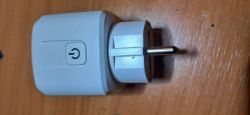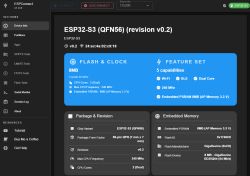Hi Community,
I would like to contribute my teardown to a power plug with energy monitoring.
The power plug is from ANTELA and is called "ANTELA Smart Plug Model: F1s202-EU".
I bought it on Amazon Germany Link.
The Tuya module WB2S is used for this power plug, which is based on the BK7231T. The energy monitory IC is the known BL0937.
The flashing was pretty easy since I could use "bk_writer1.60.exe" to get a backup of the original firmware and the same program to flash the firmware. Before writing the firmware "OpenBK7231T_UA_1.15.52.bin" I needed to erase the original one.
But before flashing we need to open the device, which is to be hones not very easy and will not happen without any damage on the housing.
With two small screwdrivers between the inlet and the housing we can manage this. Connect 3,3V, GND, TX1 and RX1 (see pictures) with your UART device of trust.
![[BK7231T - WB2S] ANTELA WiFi power plug with energy monitoring (BL0937) [BK7231T - WB2S] ANTELA WiFi power plug with energy monitoring (BL0937)](https://obrazki.elektroda.pl/2246164100_1668864684_thumb.jpg)
Ones we flashed it, use the following config:
![[BK7231T - WB2S] ANTELA WiFi power plug with energy monitoring (BL0937) [BK7231T - WB2S] ANTELA WiFi power plug with energy monitoring (BL0937)](https://obrazki.elektroda.pl/3104236800_1668864803_thumb.jpg)
In short:
Brand: ANTELA
Module: WB2S
MCU: BK7231T
Power monitoring IC: BL0937
PWM4 = P24 = BL0937 SEL
PWM1 = P7 = BL0937 CF
PWM2 = P8 = BL0937 CF1
RX = P10 = Button
PWM5 = P26 = Relay
PWM0 = P6 = LED (negated)
@p.kaczmarek2, maybe you could add this to the database.
Here some picture to compare and verify:
![[BK7231T - WB2S] ANTELA WiFi power plug with energy monitoring (BL0937) [BK7231T - WB2S] ANTELA WiFi power plug with energy monitoring (BL0937)](https://obrazki.elektroda.pl/9821062200_1668865013_thumb.jpg)
![[BK7231T - WB2S] ANTELA WiFi power plug with energy monitoring (BL0937) [BK7231T - WB2S] ANTELA WiFi power plug with energy monitoring (BL0937)](https://obrazki.elektroda.pl/4774267100_1668865018_thumb.jpg)
![[BK7231T - WB2S] ANTELA WiFi power plug with energy monitoring (BL0937) [BK7231T - WB2S] ANTELA WiFi power plug with energy monitoring (BL0937)](https://obrazki.elektroda.pl/6219359700_1668865045_thumb.jpg)
![[BK7231T - WB2S] ANTELA WiFi power plug with energy monitoring (BL0937) [BK7231T - WB2S] ANTELA WiFi power plug with energy monitoring (BL0937)](https://obrazki.elektroda.pl/5582610000_1668865050_thumb.jpg)
![[BK7231T - WB2S] ANTELA WiFi power plug with energy monitoring (BL0937) [BK7231T - WB2S] ANTELA WiFi power plug with energy monitoring (BL0937)](https://obrazki.elektroda.pl/9236295100_1668865077_thumb.jpg)
![[BK7231T - WB2S] ANTELA WiFi power plug with energy monitoring (BL0937) [BK7231T - WB2S] ANTELA WiFi power plug with energy monitoring (BL0937)](https://obrazki.elektroda.pl/4780009900_1668865100_thumb.jpg)
I would like to contribute my teardown to a power plug with energy monitoring.
The power plug is from ANTELA and is called "ANTELA Smart Plug Model: F1s202-EU".
I bought it on Amazon Germany Link.
The Tuya module WB2S is used for this power plug, which is based on the BK7231T. The energy monitory IC is the known BL0937.
The flashing was pretty easy since I could use "bk_writer1.60.exe" to get a backup of the original firmware and the same program to flash the firmware. Before writing the firmware "OpenBK7231T_UA_1.15.52.bin" I needed to erase the original one.
But before flashing we need to open the device, which is to be hones not very easy and will not happen without any damage on the housing.
With two small screwdrivers between the inlet and the housing we can manage this. Connect 3,3V, GND, TX1 and RX1 (see pictures) with your UART device of trust.
![[BK7231T - WB2S] ANTELA WiFi power plug with energy monitoring (BL0937) [BK7231T - WB2S] ANTELA WiFi power plug with energy monitoring (BL0937)](https://obrazki.elektroda.pl/2246164100_1668864684_thumb.jpg)
Ones we flashed it, use the following config:
![[BK7231T - WB2S] ANTELA WiFi power plug with energy monitoring (BL0937) [BK7231T - WB2S] ANTELA WiFi power plug with energy monitoring (BL0937)](https://obrazki.elektroda.pl/3104236800_1668864803_thumb.jpg)
In short:
Brand: ANTELA
Module: WB2S
MCU: BK7231T
Power monitoring IC: BL0937
PWM4 = P24 = BL0937 SEL
PWM1 = P7 = BL0937 CF
PWM2 = P8 = BL0937 CF1
RX = P10 = Button
PWM5 = P26 = Relay
PWM0 = P6 = LED (negated)
@p.kaczmarek2, maybe you could add this to the database.
Here some picture to compare and verify:
![[BK7231T - WB2S] ANTELA WiFi power plug with energy monitoring (BL0937) [BK7231T - WB2S] ANTELA WiFi power plug with energy monitoring (BL0937)](https://obrazki.elektroda.pl/9821062200_1668865013_thumb.jpg)
![[BK7231T - WB2S] ANTELA WiFi power plug with energy monitoring (BL0937) [BK7231T - WB2S] ANTELA WiFi power plug with energy monitoring (BL0937)](https://obrazki.elektroda.pl/4774267100_1668865018_thumb.jpg)
![[BK7231T - WB2S] ANTELA WiFi power plug with energy monitoring (BL0937) [BK7231T - WB2S] ANTELA WiFi power plug with energy monitoring (BL0937)](https://obrazki.elektroda.pl/6219359700_1668865045_thumb.jpg)
![[BK7231T - WB2S] ANTELA WiFi power plug with energy monitoring (BL0937) [BK7231T - WB2S] ANTELA WiFi power plug with energy monitoring (BL0937)](https://obrazki.elektroda.pl/5582610000_1668865050_thumb.jpg)
![[BK7231T - WB2S] ANTELA WiFi power plug with energy monitoring (BL0937) [BK7231T - WB2S] ANTELA WiFi power plug with energy monitoring (BL0937)](https://obrazki.elektroda.pl/9236295100_1668865077_thumb.jpg)
![[BK7231T - WB2S] ANTELA WiFi power plug with energy monitoring (BL0937) [BK7231T - WB2S] ANTELA WiFi power plug with energy monitoring (BL0937)](https://obrazki.elektroda.pl/4780009900_1668865100_thumb.jpg)
Cool? Ranking DIY








![[BK7231T - WB2S] ANTELA WiFi power plug with energy monitoring (BL0937) [BK7231T - WB2S] ANTELA WiFi power plug with energy monitoring (BL0937)](https://obrazki.elektroda.pl/4260076700_1682363154_thumb.jpg)
![[BK7231T - WB2S] ANTELA WiFi power plug with energy monitoring (BL0937) [BK7231T - WB2S] ANTELA WiFi power plug with energy monitoring (BL0937)](https://obrazki.elektroda.pl/4338606900_1682363169_thumb.jpg)
![[BK7231T - WB2S] ANTELA WiFi power plug with energy monitoring (BL0937) [BK7231T - WB2S] ANTELA WiFi power plug with energy monitoring (BL0937)](https://obrazki.elektroda.pl/5758567100_1682368938_thumb.jpg)